| The Asahi Shinbun Weekend Beat
July 28 2007 |
|
By MAYUMI SAITO staff Writer |
| Ancient Waterfall ritual appeals to city slickers |
"Once you're under the fall, hang in there for the first minutes. Your
body should warm up. If you can't remain, raise your hand and we'll pull you
out." Rie Miyake assistant director.
The Group washed their
hands and necks with sake at a little shrine.
They prayed for safety as
instructor Kunio Ichikawa chanted a mantra.
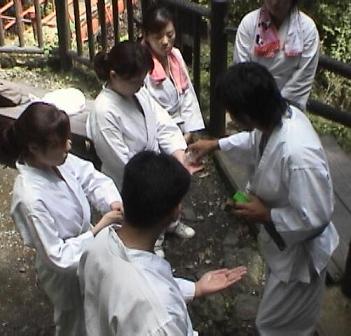
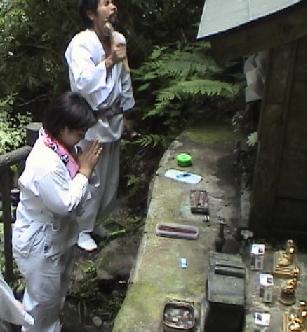
About to step onto slippery
rocks under a waterfall they would need all the help they could
get.
Next, the 10 participants, all dressed in dreamy white karate
outfits, formed a circle and loosened up.
Most were
women.
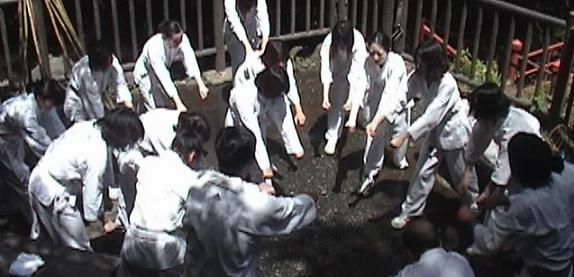
Assistant instructor Rie Miyake offered final instructions:
'Once you're under the fall, hang in there for the first minute.
Your body
should warm up.
If you can't remain, raise your hand and we'll pull you
out."
Yuhi-no-Taki (sunset waterfall) in Minami-Ashigara, Kanagawa
Prefecture, looked especially cold as it poured off the mountain on a chilly day
earlier this month.
The group bowed to the fall.
"Please take
care of us,"
they said in unison.
In case the waterfall wasn't
listening or in an evil mood, each person carried a bamboo pole.
They chanted
and stepped into the pool near the fall, using the poles to maneuver over the
rocks.
After a minute in the basin, they approached the
waterfall.
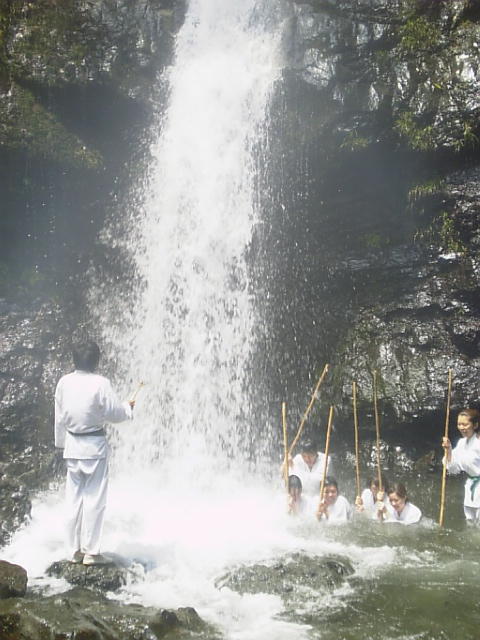
As it crashed down on their heads, each stabbed their pole into
the water, using it as an anchor.
"Keep your heads up," Miyake
called.
Some flinched as the water cascaded over them.
But they held fast,
standing under the bracing fall.
Some stayed for 20 minutes, others for
30.
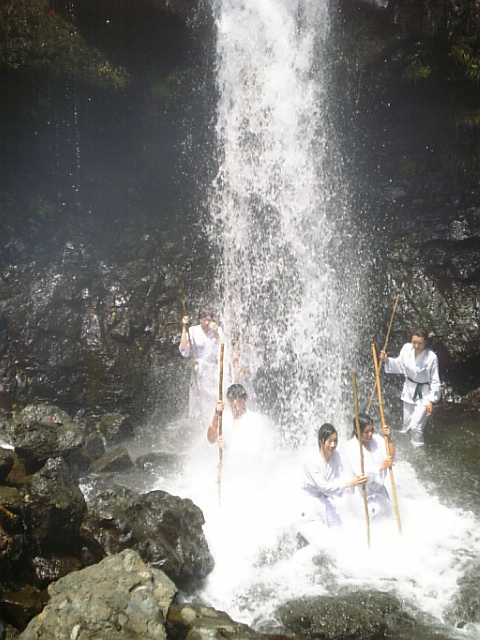
"It was intimidating and painful at first," 25-year-old nurse Yukie
Murakami said, but her voice was cheerful as
she stepped out of the
water.
Her day at Yuhi-no-Taki-a 90-minute train ride plus a 15-minute
bus ride from Tokyo-was her first experience with ascetic
training.
"But it wasn't bad. I feel refreshed," she said.
"It
was warm in the water once I got used to it.
I didn't get cold until I
got out."
Hironori Shimizu, 32, was another first-timer.
He
said he was determined to find his limit, but he had to leave the water before
the rest of the group.
He ignored lchikawa and Miyake's warnings and
returned to the waterfall repeatedly.
When the group finally pulled him out
he was groggy ;his limit reached and exceeded.
"Now I realize that I'm still
too weak ,"Shimizu said, as disappointment clouded his face.
Suffering from
depression ,he took a leave of absence from his railway job in June.
He said
too much pride ,"had interfered with his job.
He joined the group all the way
from Aichi-prefecture hoping to "gain enough momentum to star tover.
Waterfall ablution can be traced back to ascetic training practiced by
shingon-sect Buddhist monks in the Heian Period (794-ll85).
It
proliferated to other sects, incorporating elements of Zen, Japanese anjmism and
Shintoism.
Waterfall rituals have been conducted for
centuries.
Aside from monks, average folk seeking physical and
spiritual training often brave waterfalls.
Some devotees practice
year-round.
Although leader lchikawa, 56, uses traditional methods,
including dressing participants in white clothing and chanting mantras while
waving animistic sticks, he said his five-year-old group, Shonan Takigyo-no-kai
(Shonan waterfall training society), has no religious mission.
He
promotes the waterfall ritual as a form of stress release, exercise and
meditation.
The waterfall group is only one part of his training center
LoveBody Shonan in Fujisawa, Kanagawa Prefecture, established in
2002.
The center offers an eclectic mix of activities, including diet
and fasting camps, hiking, yoga, qigong exercise therapy and
massage.
"This is where tired people come to rest and rehabilitate,"
Ichikawa said.
Wbile many of the predominantly women guests join the
fasting camp to lose a little weight, others are in need
of
spiritual/psychological help.
Quite a few participants
suffer from depression, neurosis, anorexia or bulimia, according to Ichikawa.
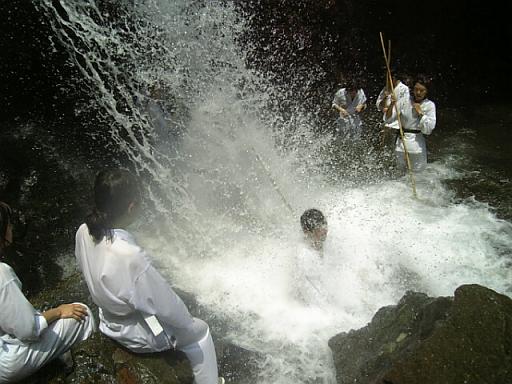
The waterfall excursion is the most popular of the center's
offerings.
Visitors may choose the waterfall ritual only or take part
in many activities over a longer stay.
The Shonan group's takigyo
training takes place under either the 25-meter high Yuhi-no-Taki, or the
70-meter-high Shasui-no-Taki.
Shasui means purification water in
esoteric Buddhism.
Both falls are located in a mountainous area in the
Ashigara district.
The center charges 5500 yen for the waterfall
excursion and provides the karate outfits.
Participants should bring
gym shoes to wear in the water, a couple of towels and something to wear under
the
karate outfits-either shorts and a T-shirt or a
swimsuit.
ASsistant leader Miyake, 27, said she was a stressed-out
office worker when she first came to the center a year ago to take part in a
detoxification/fasting program.
She enjoyed her experience and stuck
around, helping with the waterfall ritual and clerical work.
"I don't
know if it's because of the waterfall or with other factors
combined.
But I rarely catch cold nowadays," she said, adding that she wears a wetsuit when
leading waterfall excursions in the winter.
Miho Hiraide, 25, a native
of Nagano Prefecture, has
taken part in the waterfall ritual seven
times.
"Things that are on my mind fade away one after another while I'm in
the waterfall.
It serves as an emotional as well as a physical detox ," she
said.
She first arrived with Sumi Nasu, 43, for the waterfall ritual
about a month ago.
Nasu also described the waterfall ablution as a
refreshing experience,
adding that the water crashing down on her also
provided an unusual body massage.
Another participant,Yuji Maeda, 48,
watched the waterfall ritual twice before trying it himself.
Now, he is
a regular throughout the seasons.
He said he is convinced the waterfall
stimulates the autonomic nerves throughout his body.
Hoping to cure a
skin allergy, Hiraide also took part in the two-week fasting
camp.
Participants drink vegetable juice and soy milk three times a day
and munch on sour plums occasionally.
Returning to her regular diet,
Hiraide decided to remain at the center to relax for awhile.
The rash
she had on her hands appears to have vanished.
She said she quit her
temporary job in the construction industry in Nagano Prefecture in the
spring.
She now helps out at the center in exchange for room and
board.
"Most jobs are part of the daily grind. Here, every day is
different with so many activities available.
These small excitements become a
form of therapy." Ichikawa said.
"People come and go. We don't force
them to do anything.
We offer tips when asked,
" Miyake said. "Those
who want to sleep can stay in bed for three or four days.
We don't pick
on those snacking during fasting, either.
Everyone can make their own
plans here,"
The Shonan Takigyo-no-kai group takes part in a waterfall
ritual at Yuhi-no-Takl in Minami-Ashigara in Kanagawa
|

